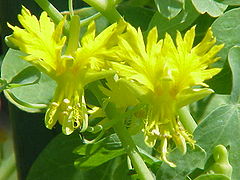Tropaeolum peregrinum
| Tropaeolum peregrinum subsp. var. | Canary creeper | |||||||||||||||||||||||||||||||||||||||||||||||||||||||
|---|---|---|---|---|---|---|---|---|---|---|---|---|---|---|---|---|---|---|---|---|---|---|---|---|---|---|---|---|---|---|---|---|---|---|---|---|---|---|---|---|---|---|---|---|---|---|---|---|---|---|---|---|---|---|---|---|

|
|
| ||||||||||||||||||||||||||||||||||||||||||||||||||||||
| ||||||||||||||||||||||||||||||||||||||||||||||||||||||||
Tropaeolum peregrinum (canary creeper, canarybird flower, canarybird vine, or canary nasturtium) is a species of Tropaeolum native to western South America in Peru and possibly also Ecuador.[1][2]
It is a climbing plant growing to 2.5 m high by scrambling over other vegetation. The leaves are 2–5 cm diameter, palmately lobed with three to seven (mostly five) lobes; they are subpeltate, with the petiole attached within the leaf (not at the edge), though near the edge. The flowers are 2–4 cm diameter, with five frilled petals, bright pale yellow (canary-coloured, hence the English name), often with red spots at the base of the petals, eight stamens, and a 12 mm nectar spur at the rear.[2]
It is widely grown as an ornamental plant in many parts of the world.
| Standard Cyclopedia of Horticulture |
|---|
|
Tropaeolum peregrinum, Linn. (T. canariense, Hort.). Canary- Bird Flower. Annual, tall-climbing; glabrous: lvs. peltate near the margin, cordate-orbicular, divided to about the middle into 5 lobes, which are mostly apiculate: fls. canary-yellow, odd and very irregular; spur green, hooked; 2 upper petals erect and large, obovate-clawed, much fringed; 3 lower petals small and narrow and ciliate. Supposed to be native of Peru and Ecuador. B.M. 1351. B.R. 718. G.W. 10, p. 497—An excellent quick-growing vine, although the fls. can scarcely be called showy. CH
|
Cultivation
- Do you have cultivation info on this plant? Edit this section!
Propagation
- Do you have propagation info on this plant? Edit this section!
Pests and diseases
- Do you have pest and disease info on this plant? Edit this section!
Species
Gallery
-
photo 1
-
photo 2
References
- Standard Cyclopedia of Horticulture, by L. H. Bailey, MacMillan Co., 1963
External links
- w:Tropaeolum peregrinum. Some of the material on this page may be from Wikipedia, under the Creative Commons license.
- Tropaeolum peregrinum QR Code (Size 50, 100, 200, 500)
- ↑ Germplasm Resources Information Network: Tropaeolum peregrinum
- ↑ 2.0 2.1 Huxley, A., ed. (1992). New RHS Dictionary of Gardening. Macmillan ISBN 0-333-47494-5.

